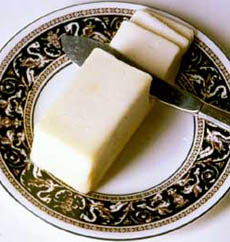Butter Glossary: A Glossary Of The Different Butter TypesPage 5: Butter Glossary M To P This is Page 5 of an 8-page article. Click on the red links below to visit other pages. This glossary is protected by copyright and cannot be reproduced in whole or part. You are welcome to link to it.
|
 Butter photo courtesy of Vermont Dairy. |
|
| MAÎTRE D’HÔTEL BUTTER A compound butter made by blending together softened butter, lemon juice or vinegar, chopped parsley and seasonings. It can be quickly turned into a sauce and is served as an accompaniment to fish, poultry and meat; and dishes so dressed are called “à la maître d’hôtel.”
|
||
| MARGARINE or OLEOMARGARINE A butter substitute made originally from other animal fats, but today made exclusively from vegetable oils. It may be substituted for butter in most recipes including baking, except for pastry recipes except as indicated, because margarine produces a softer dough than butter (and of course does not yield the wonderful buttery flavor). Like homogenization and pasteurization, margarine is a French invention. There has been a long-standing debate about the health value of cholesterol-free margarine over butter, which is high in saturated fat. While margarine is made from polyunsaturated fats like vegetable oil and corn oil, the process of turning them into semisolid spreads and solid bars creates trans fats, which are as bad or worse than saturated fats. However, most studies and health experts* suggest that certain types of margarine are a better choice. Choose the liquid and tub styles as opposed to the bar style; more trans fats are needed to make margarine more solid. Some varieties contain water or liquid vegetable oil instead of partially hydrogenated vegetable oil; read the label. However, the best alternative is a heart-healthy oil like olive oil or canola oil. *Source: The New York Times, “The Claim” column by Anahad O’Connor in “Science Times,” Tuesday, October 16, 2007, page F5.
|
||
| MEUNIÈRE BUTTER See lemon butter.
|
||
| MILK FAT See butterfat.
|
||
| MOUNT A technique where small pieces of cold, unsalted butter are whisked into a sauce just before serving. Mounting gives sauces texture and flavor as well as a glossy look.
|
||
| NEWBURG SAUCE A very rich sauce of butter, cream, egg yolks, sherry and seasonings used over cooked shellfish such as lobster, crab or shrimp. It was created by a chef of the once-famous Delmonico Restaurant in New York, M. Pascal. The sauce was originally named after a Mr. Wenburg, a frequent guest at the restaurant. Mr. Wenburg and the manager of the restaurant subsequently quarreled, and Mr. Wenburg demanded that his name be removed. The first three letters were changed to “New” to create the now-famous Newberg sauce.
|
||
| NUT BUTTER Nuts ground into a spreadable consistency of butter. Peanut butter is the most popular, but almond, cashew and hazelnut butters are popular; and any nut can be ground into a butter. Nut butters have no butter or other dairy product. Like fruit butters, they are only called butters because of their spreadable consistency.
|
 Luscious lobster Newburg. Photo courtesy MackenzieLtd.com. |
|
| OLEOMARGARINE See margarine, above. |
||
| PASTEURIZED A term describing milk that has been heat treated to destroy bacteria. |
||
| PEANUT BUTTER See nut butter, above. |
||
| POUND CAKE This is the ultimate butter cake. It gets its name (and texture) from the traditional proportions of its ingredients—one pound each of butter, sugar, eggs and flour—although over the years cooks have tinkered with the original formula and baking powder is sometimes added to the batter. |
||
| PUMPKIN BUTTER Pumpkin purée, seasoned with allspice, cinnamon and cloves, and cooked down to the consistency of a spread. See fruit butter.
Continue To The Next Page: Terms Beginning With R Content courtesy of Cornell University School of Agriculture, Wisconsin Milk Marketing Board, U.S. Department of Agriculture. |
||
Last Updated Apr 2018
© Copyright 2005-2025 Lifestyle Direct, Inc. All rights reserved. All images are copyrighted to their respective owners.